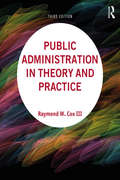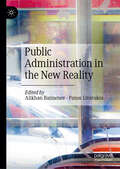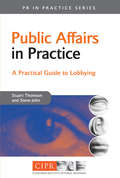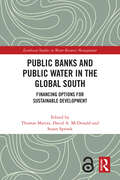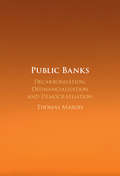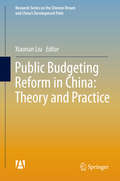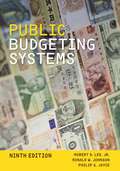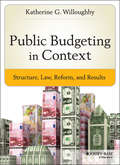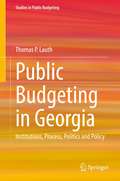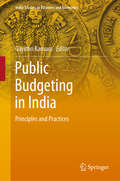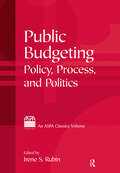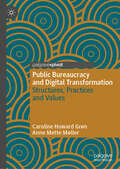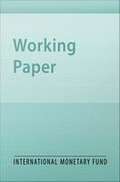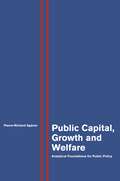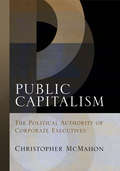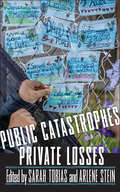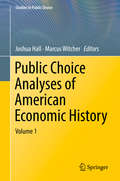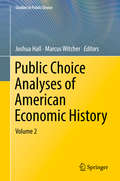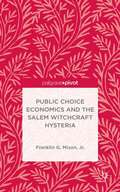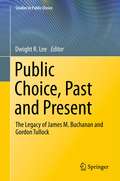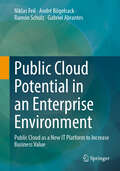- Table View
- List View
Public Administration in Theory and Practice
by Susan Buck Betty Morgan Raymond W Cox IIIHailed for its timelessness and timeliness, Public Administration in Theory and Practice examines public administration from a normative perspective and provides students with an understanding of the practice of public administration. Combining historical, contextual, and theoretical perspectives, this text give students a truly comprehensive overview of the discipline and focuses on the practical implications of public administration theory. This substantially revised third edition features: Increased emphasis on and expanded coverage of management skills, practices, and approaches, including an all-new "Managerial Toolkit" section comprising several new chapters on important topics like transboundary interactions, cultural competencies, citizen engagement, and leadership and decision-making. Expanded part introductions to provide a thematic overview for students, reinforce the multiple conceptual frameworks or lenses through which public administration may be viewed, and provide guidance on the learning outcomes the reader may anticipate. Still deeper examination of the connections between historic theoretical perspectives and current practices, to help students think through practical and realistic solutions to problems that acknowledge historic precedence and theory, yet also leave room for creative new ways of thinking. This expanded analysis also offers a forum for comparative perspectives, particularly how these practices have emerged in other countries. PowerPoint slides, Discussion Questions (with a focus on practice), Learning Outcomes, and "Things to Ponder" at the end of each chapter that may be used as lecture topics or essay examination questions. Public Administration in Theory and Practice, third edition is an ideal introduction to the art and science of public administration for American MPA students, and serves as essential secondary reading for upper-level undergraduate students seeking a fair and balanced understanding of public management.
Public Administration in the New Reality
by Alikhan Baimenov Panos LiverakosThis book combines academic insights and practitioners&’ experience from nineteen countries around the world, and it explores public administration systems capacity in predicting, facing, and reacting to, as well as operating in, the new reality. A reality characterised by considerable levels of volatility, uncertainty, complexity, and ambiguity; all amid rising geo-political tensions, climate change, digital transformation, aging populations, urbanisation, migration, and environmental degradation. These complex and intertwined policy issues put to test contemporary governance structures and current organisational arrangements for public administration systems, as well as the existing competencies and skills of public administrators. Thus, this book explores what public administration systems must do to keep up with the immense changes taking place around us and adapt to the new reality, as well as possess the capacity to forecast, to react and to learn from all past crises and manage competing and conflicting values as well.
Public Affairs in Practice: A Practical Guide to Lobbying (PR In Practice)
by Stuart Thomson Steve JohnPublic Affairs in Practice explains how public affairs (PA) is now much more than just political lobbying. Modern PA includes working with other policy-making bodies, such as regulators, commercial organizations and other interested parties.This is the first book to examine the methods PA professionals use to make an impact. It takes each area of the industry in turn and looks at the tools involved in delivering a PA programme. It also highlights the potential benefits of public affairs, such as protecting an organization from perceived threats of new regulation; identifying new market opportunities; and raising the profile of an organization. Case studies and tips from industry professionals make this a practical "how to" guide for practitioners at all levels and students.Importantly, the authors consider not only established markets the US, UK and Western Europe but also the opportunities presented to companies from these countries by the EU accession states and China, where there are currently very few PA professionals.Finally, there is a discussion of future trends and developments in PA.
Public Banks and Public Water in the Global South: Financing Options for Sustainable Development (Earthscan Studies in Water Resource Management)
by David A. McDonaldThis volume presents the first systematic review of public bank lending in the water sector in the Global South.Many public banks have an explicit mandate to finance public water management, yet despite a resurgence of interest in public banks and the role they can play in sustainable development, their role in funding water management has been largely ignored. Drawing on case studies from Asia, Africa and Latin America, this book measures the scale and nature of interaction between public banks and public water operators for the provision of safe drinking water and sanitation. It identifies challenges and opportunities for deeper engagement between public banks and public water operators in the Global South and highlights promising practices, showcasing how these might be transferred to different regions and different sectors. Each case study is based on in-depth interviews with public banks that have funded public water operators, and public water operators that have borrowed from public banks, including Banco Popular in Costa Rica, the Development Bank of the Philippines, the National Bank for Agricultural and Rural Development in India and the TIB Development Bank in Tanzania. Overall, this book provides a critical analysis of the potential of public banks to address global water security issues.This book will be of great interest to students and scholars of water resource management, water and health, sanitation and sustainable development. It will also be of interest to professionals and policymakers working with public and development banks in the supply of safe water and sanitation for all.The Open Access version of this book, available at www.taylorfrancis.com, has been made available under a Creative Commons Attribution-Non Commercial-No Derivatives (CC-BY-NC-ND) 4.0 license.
Public Banks: Decarbonisation, Definancialisation and Democratisation
by Thomas MaroisPublic banks are banks located within the public sphere of a state. They are pervasive, with more than 900 institutions worldwide, and powerful, with tens of trillions in assets. Public banks are neither essentially good nor bad. Rather, they are dynamic institutions, made and remade by contentious social forces. As the first single-authored book on public banks, this timely intervention examines how these institutions can confront the crisis of climate finance and catalyse a green and just transition. The author explores six case studies across the globe, demonstrating that public banks have acquired the representative structures, financial capacity, institutional knowledge, collaborative networks, and geographical reach to tackle decarbonisation, definancialisation, and democratisation. These institutions are not without contradictions, torn as they are between contending public and private interests in class-divided society. Ultimately, social forces and struggles shape how and if public banks serve the public good.
Public Branding and Marketing: A Global Viewpoint
by Staci M. ZavattaroThis edited volume details public branding and marketing from a global, comparative perspective. Place branding and marketing practices are now prominent in cities, states, nations, regions, and organizations all over the world. While disciplines such as hospitality management, tourism marketing, and business marketing have made inroads into understanding the intricacies of place branding, research in public administration and policy is still emerging. This volume fills that research gap. Including accounts from both the academic and practitioner communities, this book bridges the academic-practitioner divide and provides a holistic account of branding and marketing in public organizations as well as immediate application and lessons learned. The book takes an explicit public administration approach, focusing on a wide range of topics such as branding leadership, co-creation, stakeholder engagement, education, non-profit marketing and branding, and city administration. The book is divided into four sections. Section I highlights the process of developing and communicating public branding and marketing efforts. Section II focuses specifically on how social media and other digital technologies are used to communicate and evaluate place branding strategies. Section III centers on branding at the local government level. Section IV highlights how various stakeholder groups come together (or not) when participating in strategic branding efforts. Presenting various methodologies, approaches, and implications of place branding and marketing across differing social, cultural, political, and economic conditions, this book will be of use to scholars and students in public. administration, tourism studies, and business administration as well as professionals and practitioners in the public branding and marketing field.
Public Budgeting Reform in China: Theory and Practice
by Xiaonan LiuThis book introduces the theory and practice of Chinese public budget reform, including the manner and implications of public budget reform, the role and status of central government and local governments in budget reform, as well as the latest achievements of China's local government public budget reform. The authors of this book are all researchers who have witnessed Chinese public budget reform.
Public Budgeting Systems
by Robert D. Lee Ronald W. Johnson Philip G. JoyceNow in its Ninth Edition, Public Budgeting Systems is a complete and balanced reference that surveys the current state of budgeting throughout all levels of the United States government. The text emphasizes methods by which financial decisions are reached within a system as well as ways in which different types of information are used in budgetary decision-making. It also stresses the use of program information, since, for decades, budget reforms have sought to introduce greater program considerations into financial decisions. <p><p> The Ninth Edition has been updated to give particular attention to several recent developments in public budgeting and finance including: <p> - Steps that have been taken by governments to battle the effects of the "Great Recession" and to enhance economic recovery. In the US, this includes the actions of the Federal Reserve as well as legislative efforts, such as the American Recovery and Reinvestment Act. <p> - Significant increase in use of fiscal policy tools to stimulate economic recovery, in contrast to most recent previous 20 year period. <p> - The federal government's direct role in the operations of the private sector will be explored. The government has become a major stockholder and therefore has a financial stake in seeing that corporations succeed. <p> - Unprecedented federal deficits, as well as extreme budgetary challenges at the state and local level, including a discussion of causes and possible solutions. <p> - Other changes during the Obama presidency, including the passage of comprehensive health care reform and changes in the management agenda. <p> - Continued developments in financial and debt management, including additional GASB requirements and the effects of the recent economic contraction on the borrowing prospects for state and local governments. <p> - Additional recognition of the effects of the global economy, resulting in an increase in the pages devoted to discussing international examples.
Public Budgeting in Context: Structure, Law, Reform and Results (Bryson Series in Public and Nonprofit Management)
by Katherine G. WilloughbyPublic budgeting structure, process, legal framework and policy with examples from industrialized and developing countries Public Budgeting in Context examines budgeting at all levels of U.S. government—federal, state, and local—and in a sample of governments around the world. The book assesses the context of public budgeting in these governments, especially the legal foundations for its practice and how the process and final budgets are impacted by governance structures, laws, various budget actors and different branches of government. The author presents focused attention on the influences on government budgets of the executive, legislative and judicial branches of government, the bureaucracy, the public and the media. In light of worldwide fiscal malaise, especially during and since the Great Recession, this book illustrates the heightened complexity of the budgeting environment that pervades all governments today—industrialized or developing, large or small. For those who like to dive into the details, the book presents numerous examples of public budgeting as practiced and points to the wealth of data available for analyses of the budgetary context and process, budget shares and results regarding virtually any government of interest. Chapters cover the constitutional and statutory provisions for budgeting in selected governments. Budget and policy agenda setting and executive leadership, legislative budget powers and the influence of the judiciary on modern government budgets are exposed. Budget execution requirements of the bureaucracy, the input of customers, clients and citizens to government budgets, and media influences on public budgets and agencies are highlighted. Budget mechanics—budget types, formats, timelines and reforms—are introduced and compared. Taxes and intergovernmental revenues are considered, with predominant tax choices at every level of government in the United States and those in a select, developing country represented. The book introduces an emerging method for investigating the outcomes of government spending—human rights budget analysis—and includes as an example the assessment of budget reform and results of public health spending in one selected government. Highlights of Public Budgeting in Context Offers a comprehensive text for understanding public budgeting in governments of a variety of contexts and capacities and across different levels Written by a noted expert in the field of public budgeting and financial management Contains illustrative examples from industrialized and developing countries Guides to innumerable datasets with information about governments and their budgets Includes a companion website filled with templates for budget and fiscal analysis Unravel the complex issues of modern public budgeting using this unique presentation of its practice in a variety of governments in the U.S. and a select sample from around the world.
Public Budgeting in Georgia: Institutions, Process, Politics and Policy (Studies in Public Budgeting)
by Thomas P. LauthThis book describes the institutions and process through which the Georgia General Assembly adopts a budget, the executive-legislative branch politics that transpire during the process and the tax and spending policies that the process produces. It argues that the state’s budget is developed by fiscal conservatives within a culture of fiscal conservatism that is conducive to low taxes and low spending. It identifies the patterns and trends of taxing and spending over several decades and during the administrations of nine governors. Its chapter on the line-item veto illustrates the nature of executive-legislative budget relationships in the state. It concludes with an examination of the important milestones in the evolution of Georgia budgeting and a comparison of Georgia with other states on several dimensions. The book offers insights and assessments that will be of interest to budgeting scholars, students of state government, and citizens who want to know more about how government taxing and spending decisions are made.
Public Budgeting in India: Principles And Practices (India Studies in Business and Economics)
by Gayithri KarnamThis book explores public budgeting in India. As government finances play an important role in the social and economic development of a nation, it focuses on public budgeting in the context of India. The respective chapters not only discuss the underlying principles of budgeting, but also address the practical issues related to the government’s financial operations and their macro-economic implications. Recently there has been considerable debate surrounding the size of government, with the neo-liberal framework advocating a very limited governmental role.This book provides comprehensive information on the practical aspects of public budgeting with regard to how governments raise revenues, how they are spent, the nature of public services provided, and their implications for the social and economic development of the country against the backdrop of public budgeting theory. The topics covered include the constitutional fiscal framework; theories, structure and issues related to budgets; mechanisms of budget construction, budget execution, public budgeting and performance assessment; government accounting; and financial accountability.
Public Budgeting: Policy, Process and Politics (Aspa Classics Ser.)
by Irene S. RubinSome of the best writings on public budgeting and finance can be found in the journals that ASPA publishes or sponsors. For this volume editor Irene Rubin has brought together the best of these articles - emerging classics that address the most important theoretical and practical problems underlying public budgeting. The anthology is organized topically rather than historically, with an effort to delineate the issues needed to understand some of the more recent controversies in the field. Rubin's introductory essay and section openers frame the key issues and provide historical context for each article. The collection begins with descriptions of what public budgeting is, where it comes from, and what it is for. It moves on to the relationship between budget processes and outcomes, constraints on budgeting, the legal context in which it operates, and adaptations to those constraints such as contracting out. The book concludes with a discussion of the ethics and norms that underlie budgeting in a democracy. Throughout the anthology, the emphasis is on areas of disagreement and debate, so students can get involved and explore different viewpoints.
Public Bureaucracy and Digital Transformation: Structures, Practices and Values (Governance and Public Management)
by Caroline Howard Grøn Anne Mette MøllerThis book assesses how digitalization of public organizations affects their bureaucratic structure and features. Drawing on rich ethnographic data from two highly digitalized government agencies in Denmark, it analyses how digitalization both enhances and distorts fundamental characteristics of Weberian bureaucracy, including division of labour, hierarchy, rules and programmability, and bureaucratic discretion. The book also examines the ways in which digitalization influences demands on employees’ and managers’ expertise and relationships with other organizational actors, and demonstrates the implications of digitalization for the enactment of public bureaucratic values such as legality, transparency, accountability, and responsiveness. In doing so, it provides an analysis of the opportunities and challenges facing public bureaucracies in the digital age. Above all, the book offers a nuanced understanding of how digital transformation reshapes the public bureaucracy, and thereby one of the foundation stones on which our societies stand.
Public Capital and Growth
by Sanjeev Gupta Fabian Bornhorst Serkan Arslanalp Elsa SzeA report from the International Monetary Fund.
Public Capital, Growth and Welfare: Analytical Foundations for Public Policy
by Pierre-Richard AgénorA framework for the analysis of public investment in the developing worldIn the past three decades, developing countries have made significant economic and social progress, from improved infant mortality rates to higher life expectancy. Yet, 1.3 billion people continue to live in extreme poverty in the developing world, leading policymakers to place a renewed emphasis on policies that could promote economic efficiency and the productivity of the poor. How should these policies be sequenced and implemented to spur growth? Would a large, front-loaded increase in public infrastructure investment yield the desired growth-promoting effect?Taking a rigorous look at this kind of investment and its outcomes, this book explores the different channels through which public capital in infrastructure may affect growth and human welfare, and develops a series of formal models for understanding how these channels operate. Bringing together a vast amount of research in one unifying framework, Pierre-Richard Agénor finds that in considering investment in infrastructure, a variety of externalities need to be factored into analytical models and introduced in policy debates. Lack of access to infrastructure not only constrains the expansion of markets and private investment, it may also hinder the achievement of health and education targets. Ease of access, conversely, promotes innovation and empowers women by allowing them to reallocate their time to productive uses.Laying a solid foundation of economic facts and ideas, Public Capital, Growth, and Welfare provides a comprehensive look at the critical role of public capital in development.
Public Capitalism
by Christopher McmahonIn modern capitalist societies, the executives of large, profit-seeking corporations have the power to shape the collective life of the communities, local and global, in which they operate. Corporate executives issue directives to employees, who are normally prepared to comply with them, and impose penalties such as termination on those who fail to comply. The decisions made by corporate executives also affect people outside the corporation: investors, customers, suppliers, the general public. What can justify authority with such a broad reach? Political philosopher Christopher McMahon argues that the social authority of corporate executives is best understood as a form of political authority. Although corporations are privately owned, they must be managed in a way that promotes the public good.Public Capitalism begins with this claim and explores its implications for issues including corporate property rights, the moral status of corporations, the permissibility of layoffs and plant closings, and the legislative role played by corporate executives. Corporate executives acquire the status of public officials of a certain kind, who can be asked to work toward social goods in addition to prosperity. Public Capitalism sketches a new framework for discussion of the moral and political issues faced by corporate executives.
Public Catastrophes, Private Losses (The Feminist Bookshelf: Ideas for the 21st Century)
by Naomi Klein Marcia Gallo Christina Sharpe Ellen Malenas Ledoux Kathleen C. Riley Basuli Deb Marisa J. Fuentes Carmen Vázquez Michelle Commander Jennifer Flynn Walker Bela August Walker Smruthi Bala Kannan Stacy S. Klein Leslye Amede ObioraFrom COVID to climate-change-induced wildfires and hurricanes, we live in an era when catastrophes have become the new normal. But even though these events affect us all, some members of society are more vulnerable to harm than others. This essay collection explores how the definition of catastrophe might be expanded to include many forms of large-scale structural violence on communities, species, and ecosystems. Using feminist methodologies, the contributors to Public Catastrophes, Private Losses trace the connections between seemingly unrelated forms of violence such as structural racism, environmental degradation, and public health crises. In contrast to a news media that focuses on mass fatalities and immediate consequences, these essays call our attention to how catastrophes can also involve slow violence with long-term effects. The authors also consider how these catastrophes are profoundly shaped by government action or inaction, offering a powerful critique of how government neglect has cost lives and demonstrating how vulnerable populations can be better protected. The essays in this collection examine how public catastrophes imprint themselves on lives, as individuals and communities narrate, process, and grapple with legacies of loss. The book is thus a feminist intervention that challenges the binary between public and private, personal and political.
Public Choice Analyses of American Economic History: Volume 1 (Studies in Public Choice #35)
by Joshua Hall Marcus WitcherThis book - the first of two volumes- looks at episodes in American economic history from a public choice perspective. Each chapter discusses citizens, special interests, and government officials responding to economic incentives in both markets and politics. In doing so, the book provides fresh insights into important periods of American history, from the Acadian expulsion in 1755 to the allocation of government grants during the New Deal. This volume features the work of prominent economic historians such as Dora Costa, John Wallis, and Jeremy Atack; well-known public choice scholars such as Jac Heckelman; and younger scholars such as Vincent Geloso and Philip Magness. This book will be useful for researchers and students interested in economics, history, political science, economic history, public choice, and political economy.
Public Choice Analyses of American Economic History: Volume 1 (Studies in Public Choice #35)
by Joshua Hall Marcus WitcherThis book - the second of two volumes- looks at episodes in American economic history from a public choice perspective. Each chapter discusses citizens, special interests, and government officials responding to economic incentives in both markets and politics. In doing so, the book provides fresh insights into important periods of American history, from the First Nationalist Movement of 1783 to the perpetual renewal of the Federal Reserve in 1927. This volume features the work of prominent economic historians such as Hugh Rockoff; well-known public choice scholars such as Joshua Hall and J.R. Clark; and younger scholars such as Marcus Witcher and Zachary Gocenour. This book will be useful for researchers and students interested in economics, history, political science, economic history, public choice, and political economy.
Public Choice Analyses of American Economic History: Volume 3 (Studies in Public Choice #39)
by Joshua Hall Marcus WitcherThis book is the third installment in a series of volumes looking at episodes in American economic history from a public choice perspective. Each chapter discusses citizens, special interests, and government officials responding to economic incentives in both markets and politics. In doing so, the book provides fresh insights into important periods of American history, from the Rhode Island’s 1788 Referendum on the U.S. Constitution and the political influence of women’s clubs in the United States. The volume features economic historians such as Ruth Wallis Herndon, junior public choice scholars such as Jayme Lemke and Leo Krasnozhon, and political scientists such as Michael Faber. This volume will be useful for researchers and students interested in economics, history, political science, economic history, public choice, and political economy.
Public Choice Economics and the Salem Witchcraft Hysteria
by Jr. Franklin G. MixonPublic Choice Economics and the Salem Witchcraft Hysteria provides an economics perspective on the witchcraft episode, and adds to the growing body of work analyzing prominent historical events using the tools of economics.
Public Choice, Past and Present
by Dwight R. LeeIn 1962, economists James M. Buchanan and Gordon Tullock published The Calculus of Consent, in which they developed the principles of public choice theory. In the fifty years since its publication, the book has defined the field and set the standard for research and analysis. To celebrate a half-century of scholarship in public choice, Dwight Lee has assembled distinguished academics from around the world to reflect on the influence of this monumental publication, and, more broadly, the legacy of its legendary authors. Their essays cover a broad spectrum of topics and approaches, from the impact of public choice theory on foreign policy analysis to personal remembrances of learning from and collaborating with Buchanan and Tullock. The result is a unique collection of insights that celebrate public choice and its visionary proponents, while considering its future directions.
Public Cloud Potential in an Enterprise Environment: Public Cloud as a New IT Platform to Increase Business Value
by André Bögelsack Niklas Feil Ramón Schulz Gabriel AbrantesThe transformation to the public cloud comes with many challenges. The book explains three phases that form the basis for determining a company's position in the transformation. Each stage outlines a maturity level of transformation. An assessment framework guides the reader through the analysis of cloud readiness to identify the current stage of the organization and to reach the next stage of realizing the value of the cloud. The framework is supplemented by practical examples.
